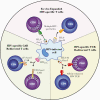Challenges and Opportunities of Using Adoptive T-Cell Therapy as Part of an HIV Cure Strategy
- PMID: 33586770
- PMCID: PMC7883023
- DOI: 10.1093/infdis/jiaa223
Challenges and Opportunities of Using Adoptive T-Cell Therapy as Part of an HIV Cure Strategy
Abstract
HIV-infected individuals successfully controlling viral replication via antiretroviral therapy often have a compromised HIV-specific T-cell immune response due to the lack of CD4 T-cell help, viral escape, T-cell exhaustion, and reduction in numbers due to the withdrawal of cognate antigen. A successful HIV cure strategy will likely involve a durable and potent police force that can effectively recognize and eliminate remaining virus that may emerge decades after an individual undergoes an HIV cure regimen. T cells are ideally suited to serve in this role, but given the state of the HIV-specific T-cell response, it is unclear how to best restore HIV-specific T-cell activity prior initiation of a HIV cure strategy. Here, we review several strategies of generating HIV-specific T cells ex vivo that are currently being tested in the clinic and discuss how infused T cells can be part of an HIV cure strategy.
Keywords: T-cell exhaustion; T-cell receptor; antiretroviral therapy; chimeric antigen receptor; ex vivo T-cell expansion; human-immunodeficiency-virus; latency reversing agent.
© The Author(s) 2021. Published by Oxford University Press for the Infectious Diseases Society of America. All rights reserved. For permissions, e-mail: journals.permissions@oup.com.
Figures

References
-
- Finzi D, Blankson J, Siliciano JD, et al. Latent infection of CD4+ T cells provides a mechanism for lifelong persistence of HIV-1, even in patients on effective combination therapy. Nat Med 1999; 5:512–7. - PubMed
-
- Siliciano JD, Kajdas J, Finzi D, et al. Long-term follow-up studies confirm the stability of the latent reservoir for HIV-1 in resting CD4+ T cells. Nat Med 2003; 9:727–8. - PubMed
-
- Okulicz JF, Marconi VC, Landrum ML, et al. Clinical outcomes of elite controllers, viremic controllers, and long-term nonprogressors in the US Department of Defense HIV natural history study. J Infect Dis 2009; 200:1714–23. - PubMed
Publication types
MeSH terms
Grants and funding
LinkOut - more resources
Full Text Sources
Other Literature Sources
Medical
Research Materials

